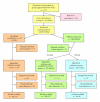Acupuncture in the inpatient acute care setting: a pragmatic, randomized control trial
- PMID: 21754946
- PMCID: PMC3132464
- DOI: 10.1155/2012/309762
Acupuncture in the inpatient acute care setting: a pragmatic, randomized control trial
Abstract
Purpose. To evaluate the acceptance and effectiveness of acupuncture in a hospital setting. Methods. This 18-month pragmatic randomized controlled trial used a two-tiered consent process for all patients admitted to the acute care unit by study physician groups. The primary study comparison was between those randomized (using biased-coin randomization after initial consent) to be offered acupuncture or not. The primary outcome was length of stay (LOS). Other measures include costs, self-reported anxiety, depression, health status, and patient satisfaction. Results. Of the 383 patients consented to the study, 253 were randomized to be offered acupuncture, and 130 were not offered acupuncture. Of those offered acupuncture, 173 (69%) accepted and received daily acupuncture. On average, patients offered acupuncture had longer LOSs (4.9 versus 4.1 days) than those not offered acupuncture (P = .047). Adjustment for diagnosis and severity mix reduced this difference and its significance (P = .108). No other significant differences in outcomes were found. Patients who were more anxious (P = .000) or depressed (P = .017) at admission tended to more often accept acupuncture when offered. Conclusion. Acupuncture is accepted by a majority of hospitalized acute care patients. However, it did not reduce LOS in this already short-stay population.
Figures

Similar articles
-
The Impact of Inpatient Acupuncture on a Mixed Hospital Floor: A Pragmatic 3-Month Cost-Effectiveness Retrospective Evaluation.Med Acupunct. 2024 Feb 1;36(1):27-33. doi: 10.1089/acu.2023.0009. Epub 2024 Feb 13. Med Acupunct. 2024. PMID: 38380172 Free PMC article.
-
Adjunctive acupuncture for pain and symptom management in the inpatient setting: protocol for a pilot hybrid effectiveness-implementation study.J Integr Med. 2016 May;14(3):228-38. doi: 10.1016/S2095-4964(16)60252-2. J Integr Med. 2016. PMID: 27181130 Free PMC article. Clinical Trial.
-
Systematic reviews of the effectiveness of day care for people with severe mental disorders: (1) acute day hospital versus admission; (2) vocational rehabilitation; (3) day hospital versus outpatient care.Health Technol Assess. 2001;5(21):1-75. doi: 10.3310/hta5210. Health Technol Assess. 2001. PMID: 11532238 Review.
-
The study protocol for a randomized, controlled trial of acupuncture versus a sham procedure versus standard care alone for the treatment of delirium in acutely hospitalized older adults with a medical illness.Maturitas. 2019 Jun;124:72-80. doi: 10.1016/j.maturitas.2019.03.001. Epub 2019 Mar 7. Maturitas. 2019. PMID: 31097183
-
Acupuncture of chronic headache disorders in primary care: randomised controlled trial and economic analysis.Health Technol Assess. 2004 Nov;8(48):iii, 1-35. doi: 10.3310/hta8480. Health Technol Assess. 2004. PMID: 15527670 Review.
Cited by
-
Integration of Doctor of Acupuncture and Oriental Medicine (DAOM) Students in a Trauma Center's Acute Pain Service: In-Person and Remote Training and Patient Care.Med Acupunct. 2022 Apr 1;34(2):88-95. doi: 10.1089/acu.2021.0041. Epub 2022 Apr 19. Med Acupunct. 2022. PMID: 35509879 Free PMC article.
-
The Impact of Inpatient Acupuncture on a Mixed Hospital Floor: A Pragmatic 3-Month Cost-Effectiveness Retrospective Evaluation.Med Acupunct. 2024 Feb 1;36(1):27-33. doi: 10.1089/acu.2023.0009. Epub 2024 Feb 13. Med Acupunct. 2024. PMID: 38380172 Free PMC article.
-
The State of 21st Century Acupuncture in the United States.J Pain Res. 2024 Oct 10;17:3329-3354. doi: 10.2147/JPR.S469491. eCollection 2024. J Pain Res. 2024. PMID: 39403098 Free PMC article.
-
Analysis and Thoughts about the Negative Results of International Clinical Trials on Acupuncture.Evid Based Complement Alternat Med. 2015;2015:671242. doi: 10.1155/2015/671242. Epub 2015 Jun 16. Evid Based Complement Alternat Med. 2015. PMID: 26161126 Free PMC article. Review.
-
A Scoping Review of Measures Utilized to Assess Patient Satisfaction with Acupuncture Treatments Within Randomized Controlled Trials.Med Acupunct. 2022 Oct 1;34(5):308-315. doi: 10.1089/acu.2022.0015. Epub 2022 Oct 17. Med Acupunct. 2022. PMID: 36311882 Free PMC article.
References
-
- Hospitalizations in the US. 2002. http://www.ahrq.gov/data/hcup/factbk6/factbk6a.htm.
-
- Sisko A, Truffer C, Smith S, et al. Health spending projections through 2018: recession effects add uncertainty to the outlook. Health Affairs. 2009;28(2):w346–w357. - PubMed
-
- Traditional Chinese Medicine: An Introduction. 2010. http://nccam.nih.gov/health/whatiscam/chinesemed.htm.
-
- Zou DCW, Katsuhiko I, Rigda R, Tippett M, Holloway R. Inhibition of transient lower esophageal sphincter relaxations by electrical acupoint stimulation. American Journal of Physiology—Gastrointestinal and Liver Physiology. 2005;289(2):G197–G201. - PubMed
-
- White A, Foster NE, Cummings M, Barlas P. Acupuncture treatment for chronic knee pain: a systematic review. Rheumatology. 2007;46(3):384–390. - PubMed
LinkOut - more resources
Full Text Sources

